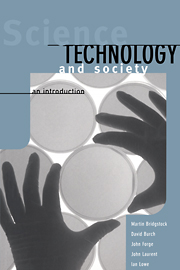Book contents
- Frontmatter
- Contents
- List of Figures
- List of Tables
- List of Contributors
- Preface
- Part One Scientific and Technological Communities
- 1 Introduction
- 2 The Scientific Community
- 3 Responsibility and the Scientist
- 4 The Rights and Wrongs of Science
- 5 Controversies Regarding Science and Technology
- Part Two Scientists and Technologists in the Wider Society
- Appendix 1 Surviving in the Information Jungle
- Appendix 2 Referencing
- Index
5 - Controversies Regarding Science and Technology
Published online by Cambridge University Press: 04 February 2010
- Frontmatter
- Contents
- List of Figures
- List of Tables
- List of Contributors
- Preface
- Part One Scientific and Technological Communities
- 1 Introduction
- 2 The Scientific Community
- 3 Responsibility and the Scientist
- 4 The Rights and Wrongs of Science
- 5 Controversies Regarding Science and Technology
- Part Two Scientists and Technologists in the Wider Society
- Appendix 1 Surviving in the Information Jungle
- Appendix 2 Referencing
- Index
Summary
Controversy is a normal and natural part of human existence, and also of science. If science is to advance at all, new theories and findings must be put forward, and older ones discarded. This often produces controversy, especially if the proponents of outdated findings and theories are still active. Therefore, how science handles controversies is an important aspect of how science actually works.
Conflict within science is inevitable, but so too is conflict in the larger community. Furthermore, an increasing number of these larger controversies involve science and technology. If an airport or freeway is to be built or expanded, questions arise about the science and technology involved: what construction techniques will be used, is there danger to anyone, is there pollution, and so on.
In this chapter, we shall review the different types of controversy, both within science and in the larger community, and also acquire some useful ideas which throw light on them. As part of this process, we shall look at two different controversies in some detail, examining the course they took, and the reasons why they worked out as they did. One of these controversies—continental drift—took place purely within science. The other—the New Zealand cervical cancer scandal—involved both science and medical technology, but took place primarily in the larger community.
Purely scientific controversies
The most straightforward type of controversy is the purely scientific one (Giere 1987).
- Type
- Chapter
- Information
- Science, Technology and SocietyAn Introduction, pp. 83 - 108Publisher: Cambridge University PressPrint publication year: 1998
- 1
- Cited by



